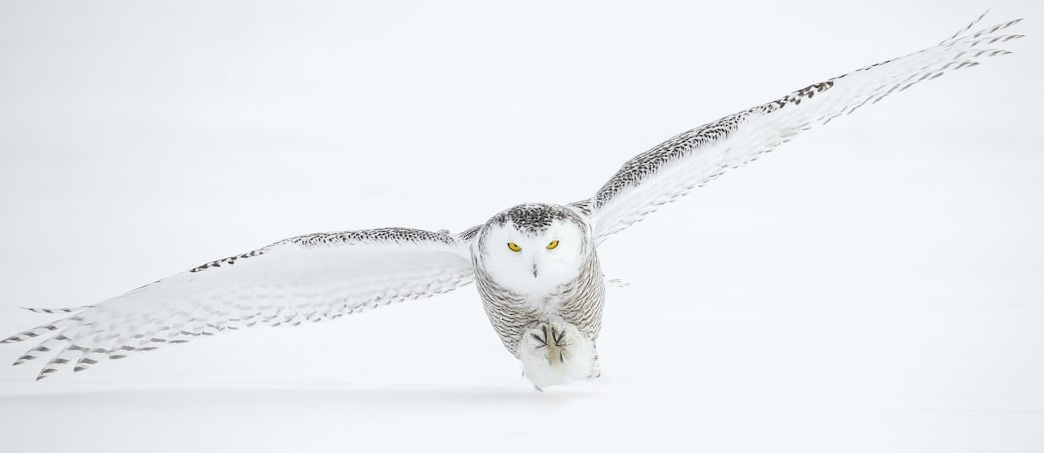Snowy Owl Numbers Are Declining Faster Than Expected, Study Finds
A new study finds that Snowy Owl numbers are far lower than previously estimated, raising concerns about their long-term survival.

The Snowy Owl (Bubo scandiacus), an iconic Canadian species, may be declining faster than previously thought according to a recent study published in December, 2024.
In 2004, experts estimated their population at around 290,000 individuals. However, new estimates from the International Snowy Owl Working Group suggest the population is closer to 14,000-28,000.1
This sharp variation is likely due to overestimates, as Snowy Owls are extremely difficult to track due to their nomadic nature.
The study further stated that breeding Snowy Owl populations in the Arctic have decreased by more than 30% in recent generations.

Snowy Owls are found across much of Canada, with their location depending on the season.
In winter, Snowy Owls will migrate south towards the Canada-US border and slightly beyond. This move is often driven by food scarcity, as the harsh winter conditions push their prey deep beneath the snow.
During the summer, Snowy Owls primarily inhabit the Arctic tundra, including inland plateaus, valleys, and coastal areas. This is also where they will breed, provided their primary food source is abundant.
In 2017, the Snowy Owl was listed as “vulnerable” globally on the International Union for Conservation of Nature, (IUCN) Red List.2 The IUCN Red List is a critical indicator of the health of the world’s biodiversity.3
Despite this, the Canadian Government lists the Snowy Owl as “apparently secure.”4
What are some of the threats Snowy Owls are facing?
Per the study, some of the threats the Snowy Owls face are climate change, changes in the availability of their primary prey, and changes to the landscape.
As climate change continues to warm the Arctic, it brings with it extended rainy periods. This rain often freezes, creating thick layers of ice. This traps the main food source of the Snowy Owl, the Lemming, under hard packed ice sheets. Lemmings are also facing their own threats from climate change,5 and a reduction in their population will have drastic affects on the survival of the Snowy Owl according to the study.
Ultimately, further research is needed to fully understand the Snowy Owl’s challenges and ensure its survival. The study underscores the importance of increased international cooperation in Snowy Owl research, as well as the valuable role of local and Indigenous knowledge. As climate change and habitat loss continue to threaten wildlife, the future of the Snowy Owl will depend on how effectively we respond to these issues.
Be sure to follow me on social media!
Instagram: https://www.instagram.com/randomphotoadventure
Facebook: https://www.facebook.com/randomphotoadventure
BlueSky: randomphotoadv.bsky.social
Have a tip, story idea, event, or want to appear as a guest column? Get in touch by emailing randomphotoadventure@substack.com
McCabe RA, Aarvak T, Aebischer A, Bates K, Bety J, Bollache L, Brinker D, Driscoll C, Elliot KH, Fitzgerald G, Fuller M, Gauthier G, Gilg O, Gousy-Leblanc M, Holt D, Jacobsen KO, Johnson D, Kulikova O, Lang J, Lecomte N, McClure C, McDonald T, Menyushina I, Miller E, Morozov VV, Øien IJ, Robillard A, Rolek B, Sittler B, Smith N, Sokolov A, Sokolova N, Solheim R, Soloviev M, Stoffel M, Weidensaul S, Wiebe KL, Zazelenchuck D, Therrien JF (2024). Status assessment and conservation priorities for a circumpolar raptor: the Snowy Owl Bubo scandiacus. Bird Conservation International, 34, e41, 1–11 https://doi.org/10.1017/S0959270924000248
BirdLife International. 2021. Bubo scandiacus. The IUCN Red List of Threatened Species 2021: e.T22689055A205475036. https://dx.doi.org/10.2305/IUCN.UK.2021-3.RLTS.T22689055A205475036.en. Accessed on 01 February 2025.
International Union for Conservation of Nature (IUCN). 2025. The IUCN Red List: Background & History. Accessed February 1, 2025. https://www.iucnredlist.org/about/background-history.
Environment and Climate Change Canada and Birds Canada. 2024. The State of Canada’s Birds – Snowy Owl. Data accessed from NatureCounts, Birds Canada. Accessed February 1, 2025. https://doi.org/10.71842/zdk2-3k19
Polar Knowledge Canada. (2021, December 17). How is climate change affecting the Arctic's smallest mammal, the lemming? Government of Canada. https://www.canada.ca/en/polar-knowledge/polar-blog-articles/how-is-climate-change-affecting-lemming.html



